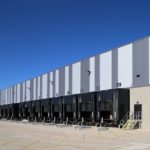Sector - Consultancy
Using Technology to Adapt

You could say that 2020 didn’t go exactly as planned. In the last six months, we’ve seen the construction industry step away from normal projects to build Nightingale hospitals such as the modular build at Nightingale Hospital Exeter, support emergency services and adapt buildings to become secure against a virus that none of us saw coming. Here Steve Breen, General Manager of Construction Industries for exclusive Cat® dealer, Finning UK & Ireland, explains how restrictive measures introduced during the COVID-19 pandemic are being countered with remote vehicle control technology and a level of agility even the industry itself didn’t realise it had.
COVID-19 has had a huge impact on our daily lives. Personally, we’ve been unable to see family and friends, we’ve had plans cancelled and many of us have also suffered financially. In the UK, construction work ground to a halt when people were asked to stay indoors for the safety of the whole population. This had a knock-on effect on downtime, supply chains, project completion deadlines and, ultimately, profits.
An alternative to buying new
Construction businesses have always seen the value in investing in new equipment and technology — the initial capital expenditure can be high, but it’s worth it as it allows them to compete for new business while keeping existing customers happy. While this attitude to technology hasn’t changed, the pandemic has increased scrutiny on spending — factors like return on investment (ROI), cost per hour, reward versus risk and comparisons with alternative options are being considered in much more detail.
As a result, there has been an increase in the number of companies rebuilding their machines instead of buying a brand-new replacement. In fact, the Finning Repair, Rebuild and Response (RRR) team has delivered £3 million of certified rebuilds in 2020 alone. The benefits are obvious to anyone looking for an alternative way of managing their fleet, by keeping all the benefits of as-new performance, for a lower price tag.
We’ve also seen increased interest in aftermarket and finance solutions offered by Cat Financial, such as extended ownership models, and an increased focus on service and maintenance.
Social distancing is here to stay
As the lockdown measures put in place to fight COVID-19 were relaxed, businesses geared back up to restart their work. This resulted in a marked increase in demand for construction equipment. The desire to avoid face-to-face contact, plus varying geographical restrictions, has completely changed how we interact with customers, and means that it’s now less common to go to site to physically walk around and inspect a machine.
Looking forward, I predict that construction work will scale up rapidly to make up for lost time on projects, while also maintaining strict social distancing and COVID safety regulations, — which will be around for the foreseeable future. This could lead to more widespread use of digital technologies that enable remote diagnostics for predictive maintenance and semi-autonomy, helping companies to stay resilient.
Take it off-site
These restrictions will also increase the use of remote services and remote vehicles on the jobsite. For example, Cat COMMAND®, allows operators to use line-of-sight (LOS) technology, which enables remote control of the machine from up to 400 metres away, or non-line-of-sight (NLOS) technology, which allows machine operation from any distance using Wi-Fi.
LOS technology controls are integrated with machine electronics to provide the same control and response as if you were in the cab, allowing the operator to maintain productivity on a portable console from a distance. Operating commands are sent directly to the machine’s electronics and hydraulic systems via a dedicated radio transmitter/receiver, resulting in real-time feedback. Also, by removing the user from the cab, it eliminates machine vibration felt by the operator, reducing fatigue.
NLOS technology, where simulators replicate the control position of the operator to allow remote control, no matter the distance, will make big ripples through the industry and will bring many more benefits than just increased safety.
For smaller companies, a single user of NLOS technology can easily switch control between multiple machines on multiple jobsites, reducing travel time and improving operating efficiencies — especially in situations where the workflow would usually be disrupted by bad weather. It also allows for construction to begin again immediately after a disruptive or hazardous process, like blasting. This is a huge benefit for the demolition industry.
NLOS can also tackle one of the UK construction industry’s biggest issues — the shortage of skilled workers. NLOS technology makes machine operation more accessible for several reasons. Firstly, it opens up the opportunity to accommodate both those with physical limitations and older workers, the largest demographic in construction, keeping them in the industry for longer. Using NLOS, they’re able to operate a machine safely, from a distance, which may be more suitable for someone struggling with a health condition.
NLOS technology will help create an industry that thrives on modern technology. Construction is generally seen as one of the UK’s least digitalised industries, which is off-putting for our young workers who grew up surrounded by technology. These workers want and need opportunities to use their digital skills in their jobs, so we should continue using the latest technology in our construction practices, now and in the future.
Throughout the uncertainty of 2020, the construction industry has adapted to survive by taking advantage of cost-saving solutions and enhanced technology that ultimately enabled it to restart. While technology like NLOS has risen to prominence in response to social distancing and current restrictions, its potential impact on other industry issues will slowly start to show in 2021.
If you would like to read more like this, then please click here
Related Articles
More Consultancy Features
- Outlook for the property and construction sector heading into 2025
17 Dec 24
Across the residential, rental and infrastructure sectors, there will be many challenges in 2025, as well as many opportunities.
- No compare – why framework comparison is a risky business
23 Jan 23
At a time when the framework market is more competitive than ever, it can be tempting for public sector organisations to choose the lowest cost.
- Physics engineering to go mainstream in 2022
8 Feb 22
Building physics engineers will become mainstream during 2022.






